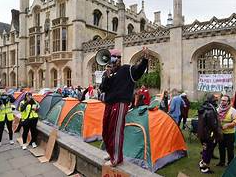Pro-Palestine protests are proliferating across Western universities – but only the US has responded with military-grade police violence.
Pro-Palestinian protests have made their way across the globe, notably sparking university campus movements in the US, the UK, and beyond. The most significant protests have occurred in the United States, where students have demanded their universities cut ties with companies linked to Israeli occupation and the weapons industry. These protests have been met with severe backlash, including military-grade police responses, with university administrations taking drastic measures to quell the dissent.
In the UK, students at prestigious universities such as Oxford and Cambridge have also set up “liberation zone” camps and rallied for the cause of Palestine. These protests, while loud and politically charged, have been notably smaller and less intense than those in the US. Despite this, the goals have been similar: to push for universities to disinvest from companies associated with the Israeli government, challenge military interventions, and demand greater transparency on institutional complicity in the Israeli occupation.
One of the demands made by US protesters—specifically the divestment from companies profiting from arms and military technologies used in the Israeli-Palestinian conflict—has already been met by several UK institutions, although students there continue to push for more action. At Oxford, for example, protesters have also been calling for an end to academic partnerships with Israeli universities and for reparations to help rebuild Palestinian educational institutions that have been damaged or destroyed by ongoing conflict.
In contrast to the more peaceful protests seen in the UK, American campuses have faced aggressive crackdowns by law enforcement. Military-grade police tactics have been employed against student protestors in several instances, marking a stark difference between the US and Europe in their response to such demonstrations. Critics argue that the US government’s response is disproportionate and reflects a broader pattern of heavy-handedness in policing dissent.
The divide in responses between the US and Europe reveals the distinct political and cultural landscapes in which these protests have emerged. In Europe, the history of colonialism, the rise of nationalist movements, and political ideologies surrounding Israel-Palestine have shaped the way these protests are perceived and handled. Meanwhile, in the US, student movements have sparked a deeper political debate about free speech, activism, and the role of universities in political matters.
In the broader context, these protests underscore the global nature of the Israel-Palestine conflict and how it resonates with youth movements worldwide. As young people in the West increasingly rally behind Palestinian causes, the US’s militarized response has only fueled criticism of its stance on the issue. Meanwhile, students in the UK and Europe continue to show solidarity with Palestine, raising questions about how universities and governments will respond to growing political activism on campuses.
Ultimately, these student protests serve as a barometer of global solidarity for Palestine, as well as a reminder of how the US, in particular, has responded to movements it perceives as challenging the status quo. The disparity in responses between the US and Europe underscores the complexities of international solidarity and the diverse ways in which political activism is both supported and suppressed.

